VITA 1600 Wilson Boulevard, Suite 500 Arlington, Virginia 22209 USA Tel: 703/276-1800 . Fax: 703/243-1865 Internet: pr-info@vita.org
Understanding Passive Cooling Systems ISBN: 0-86619-265-4 [C]1986, Volunteers in Technical Assistance
PREFACE
This paper is one of a series published by Volunteers in Technical Assistance to provide an introduction to specific state-of-the-art technologies of interest to people in developing countries. The papers are intended to be used as guidelines to help people choose technologies that are suitable to their situations. They are not intended to provide construction or implementation details. People are urged to contact VITA or a similar organization for further information and technical assistance if they find that a particular technology seems to meet their needs.
The papers in the series were written, reviewed, and illustrated almost entirely by VITA Volunteer technical experts on a purely voluntary basis. Some 500 volunteers were involved in the production of the first 100 titles issued, contributing approximately 5,000 hours of their time. VITA staff included Bill Jackson as editor, Suzanne Brooks handling typesetting and layout, and Margaret Crouch as project manager.
The author, reviewers, and illustrator of this paper are all VITA Volunteers. The author, VITA Volunteer Dan Halacy, is past Vice Chariman and Director of the American Solar Energy Society and presently on the Editorial Board of the International Solar Energy Society. He has served with the Arizona Solar Energy Commission and the Solar Energy Research Institute, holds three solar patents, and has published eight books and papers on solar energy. Reviewer Thomas Beckman is currently studying artificial intelligence at the Massachusetts Institute of Technology, and has studied solar energy applications at George Washington University in Washington, D.C. Reviewer Dan Dunham is a professor at Columbia University in New York City. He has worked in Asia, Africa, and the Caribbean on building design, rural housing, and settlement planning projects. Reviewer Dan Ingold is a test engineer for the Hayward Tyler Pump Company in Burlington, Vermont. Illustrator George Clark teaches drafting, design, and technical illustration at Kellogg Community College in Battle Creek, Michigan.
VITA is a private, nonprofit organization that supports people working on technical problems in developing countries. VITA offers information and assistance aimed at helping individuals and groups to select and implement technologies appropriate to their situations. VITA maintains an international Inquiry Service, a specialized documentation center, and a computerized roster of volunteer technical consultants; manages long-term field projects; and publishes a variety of technical manuals and papers.
I. INTRODUCTION
Passive cooling systems use simple, low-cost techniques to provide summer comfort in warm climates for people and animals in buildings. Such systems can also be used to keep food, liquids, and other materials at temperatures that will prevent spoiling or other deterioration.
Passive cooling is far less costly to operate than active cooling systems such as air conditioning which typically use vapor-compression or absorption refrigeration and require complex electromechanical equipment and a power supply. Passive cooling methods use simple mechanisms and require no input of electrical energy or conventional fuels.
The need for passive solar cooling, and the selection of appropriate methods for achieving it, depend primarily on the climatic conditions of a region, the cultural context, and the materials available locally.
The History of Passive Cooling
Throughout history, humans and animals have learned and benefited from passive cooling techniques. Most creatures seek shade for protection against heat. Homes are often built in wooded areas. Favorable breezes are sought.
Historically, building materials have often been chosen for their effectiveness in tempering solar heat in summer. Some builders in temperate regions have adopted the low mass approach, using walls and floors of wood, which doesn't store much heat. Others, needing insulation against winter cold, have learned to use dense adobe or masonry walls. In summer these delay the infiltration of heat until evening, when the structure can be opened and cooled with night air, breezes, and radiation to the night sky.
An ancient and very effective passive cooling method involves building in caves of limestone or other workable material. The temperature of rock below the surface remains relatively stable(), winter warmth as well as summer cooling.
() at the mean annual temperature on the surface.
In ancient times the Persians learned to cool their buildings with thermal chimneys, tall towers that warmed in the sun and drove warm air up and out (because warm air rises), and thus pulled cooler air into the building through openings near the ground on the shady side.
The modern concept of passive cooling is based on these old and effective methods, plus better knowledge and materials.
Basic Theory
Passive solar cooling uses two basic concepts: preventing heat gain, rejecting unwanted heat.
The first concept, that of heat-gain control, is of far greater importance than is generally recognized. Factors involved include:
1. Site considerations Location Orientation Vegetation Land massing Microclimate modification
2. Architectural features Building exposure Surface/volume ratio Screens Shades Wingwalls Overhangs
3. Building component features Insulation Glazing Mass Material type Texture Finishes
The second concept, the rejection of unwanted heat, can be divided into three major categories: (1) Direct loss (see Figure 1);
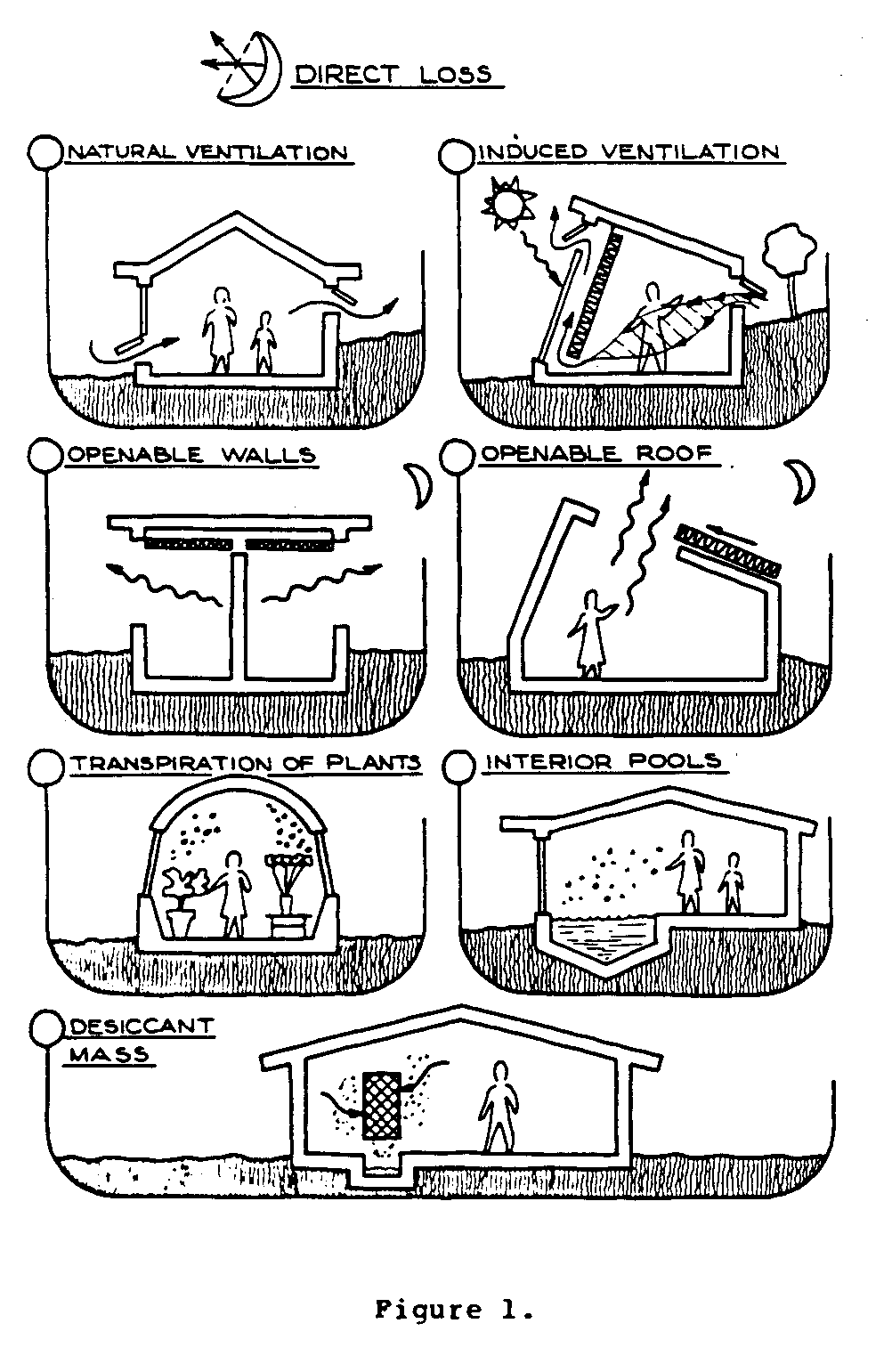
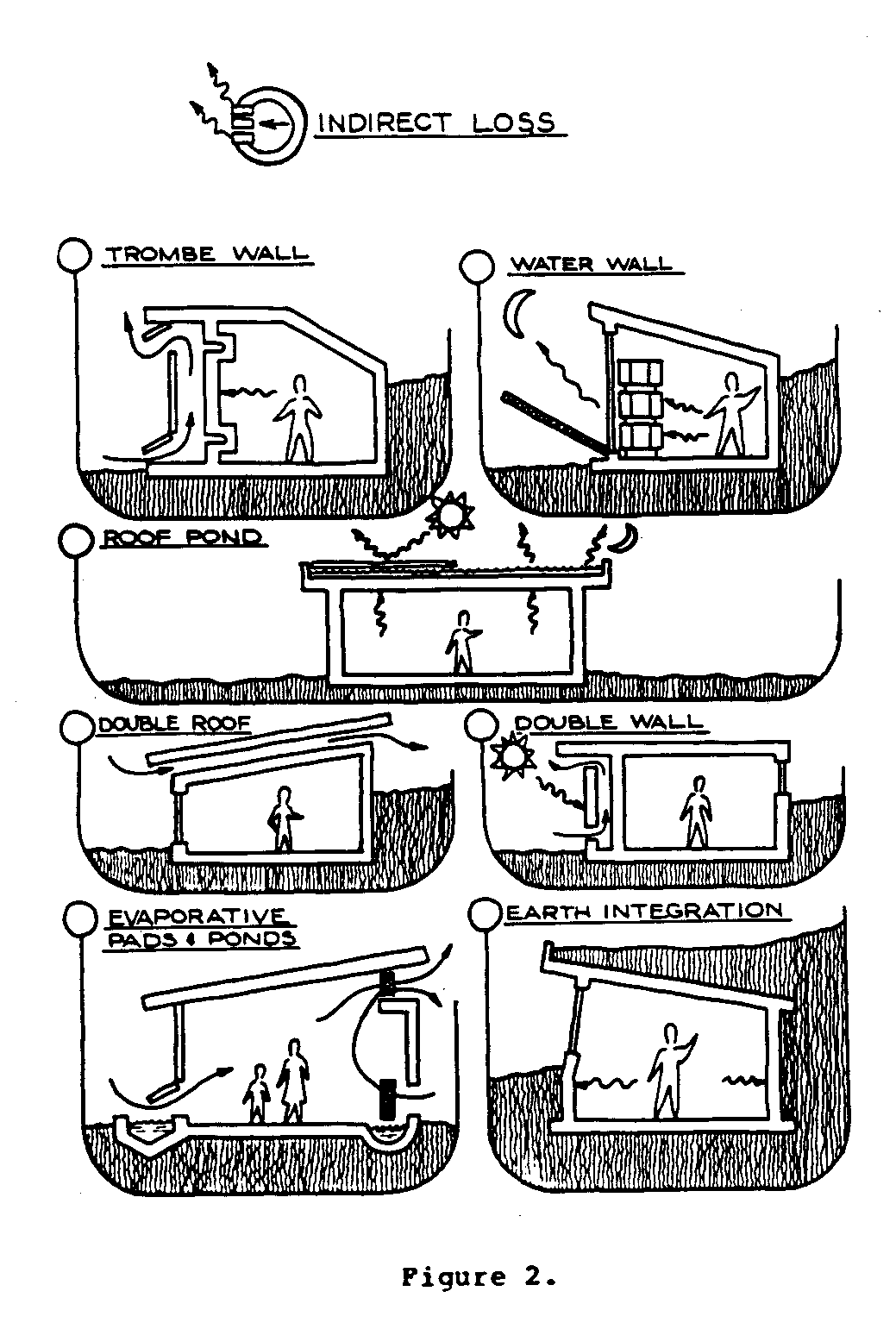
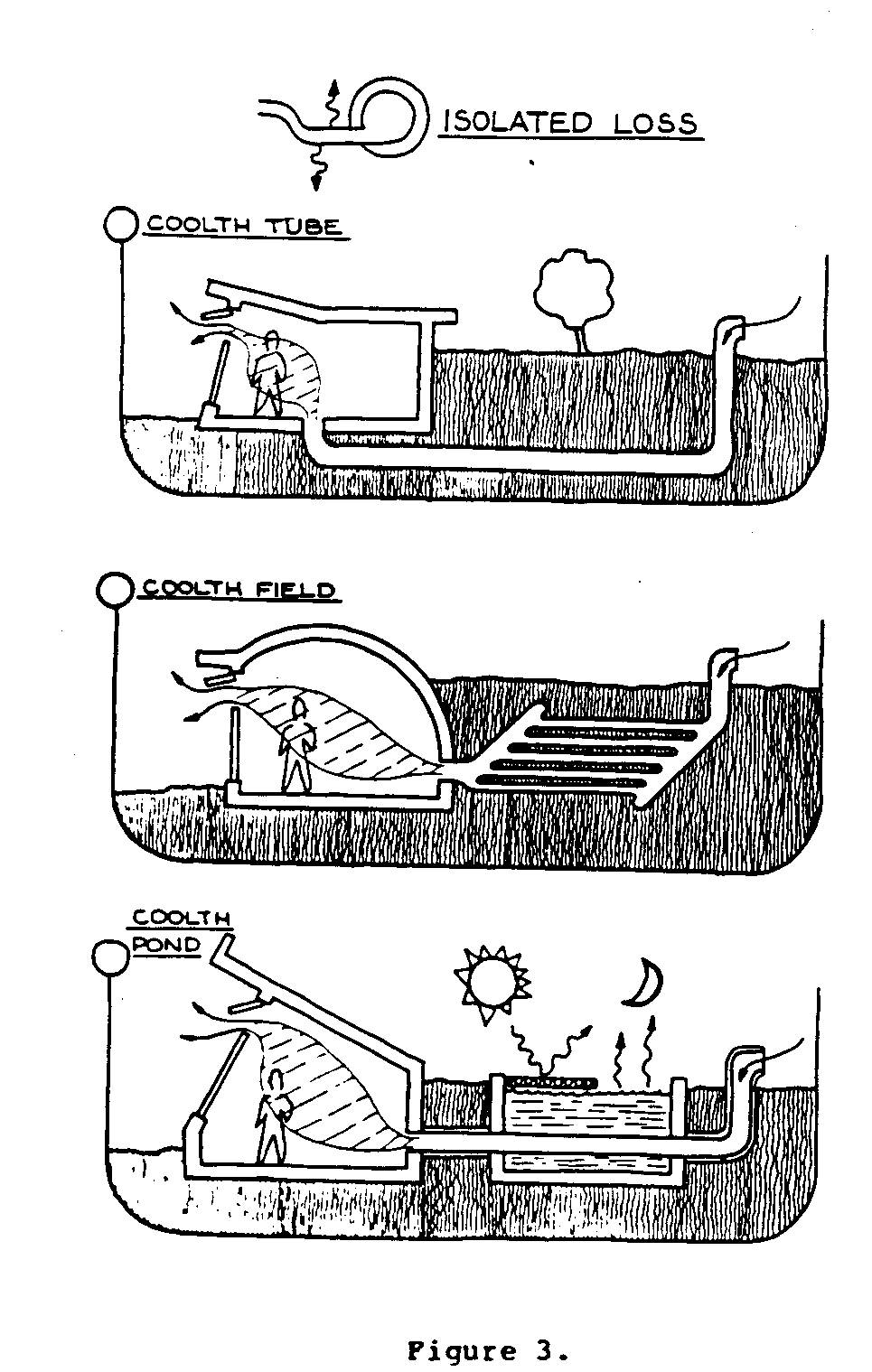
(2) Indirect loss (see Figure 2); and (3) Isolated loss (see Figure 3).
A thermal chimney or mechanical means are required to drive the air flow as shown in the three drawings above.
These objectives of heat gain control and the rejection of unwanted heat are accomplished by the following different methods:
1. Shading from the sun 2. Reflection of solar heat 3. Insulation 4. Ground cooling 5. Wind cooling (natural breeze or induced convection) 6. Water cooling 7. Evaporative cooling 8. Dehumidification 9. Night radiant cooling 10. Night cooling of thermal mass in buildings 11. Exotic passive cooling methods 12. Seasonal cold storage
Applications for Passive Cooling
Passive cooling techniques can be applied to residences and other buildings and to storage areas for food, liquids, and other materials that may be damaged by overheating. Passive cooling obviously is of most value in hot climates, particularly where conventional active cooling equipment is unavailable or unaffordable.
Availability of passive cooling also depends on such factors as climate, cloud cover, night sky conditions, and availability of water.
In arid climates where water is available, evaporative cooling is a low-cost method of providing comfort in high temperatures. Yet, this approach is of little value in humid climates where the air is already saturated with moisture; in such climates dehumidification may be needed to provide comfortable passive cooling.
Thus, passive cooling differs in different places and situations. The methods used depend on the specific site and environment. Not all methods will be useful in every application and set of conditions.
II. PASSIVE COOLING METHODS
The various methods of achieving passive cooling can be used separately or combined, depending on site, climate, available materials and skills, and economic considerations. The discussion that follows treats the different passive cooling methods in order of their simplicity and cost effectiveness.
Shading from the Sun
The simplest and most effective passive cooling technique is to keep the sun's heat from entering a building (Figure 4). This is

accomplished primarily by shading, using:
* The building itself (roof, walls) * Other buildings, terrain features * Supplemental shade (trees, vines, etc.) * Awnings, shutters, curtains, drapes
When a new building is planned, shading should be included for effective heat prevention. With an existing building, benefits may be constrained by its design and by the amount of money and labor available for upgrading the building.
The provision of supplemental shading, such as vegetation or awnings, is only a first step. Trees must be kept healthy, so they will continue to provide shade as well as the evaporative cooling their transpiration of moisture yields. Movable shades must be properly maintained and effectively operated to keep solar heat out of a building during the day but allow circulation of cooler air at night.
Reflection of Solar Heat
Light-colored roofs, walls, and other shading have the important advantage of reflecting much more heat than darker materials do. A white roof may absorb only 25 percent of solar heat, far less than the 90 percent absorbed by a black one. This greatly reduces the amount of heat getting into the building and simplifies the task of comfort cooling.
Aluminum foil installed in an attic or ceiling (shiny side up) further reduces the amount of radiant heat getting into the building. Reflective films can be applied to windows and other glass areas to keep out more heat while remaining transparent.
Insulation
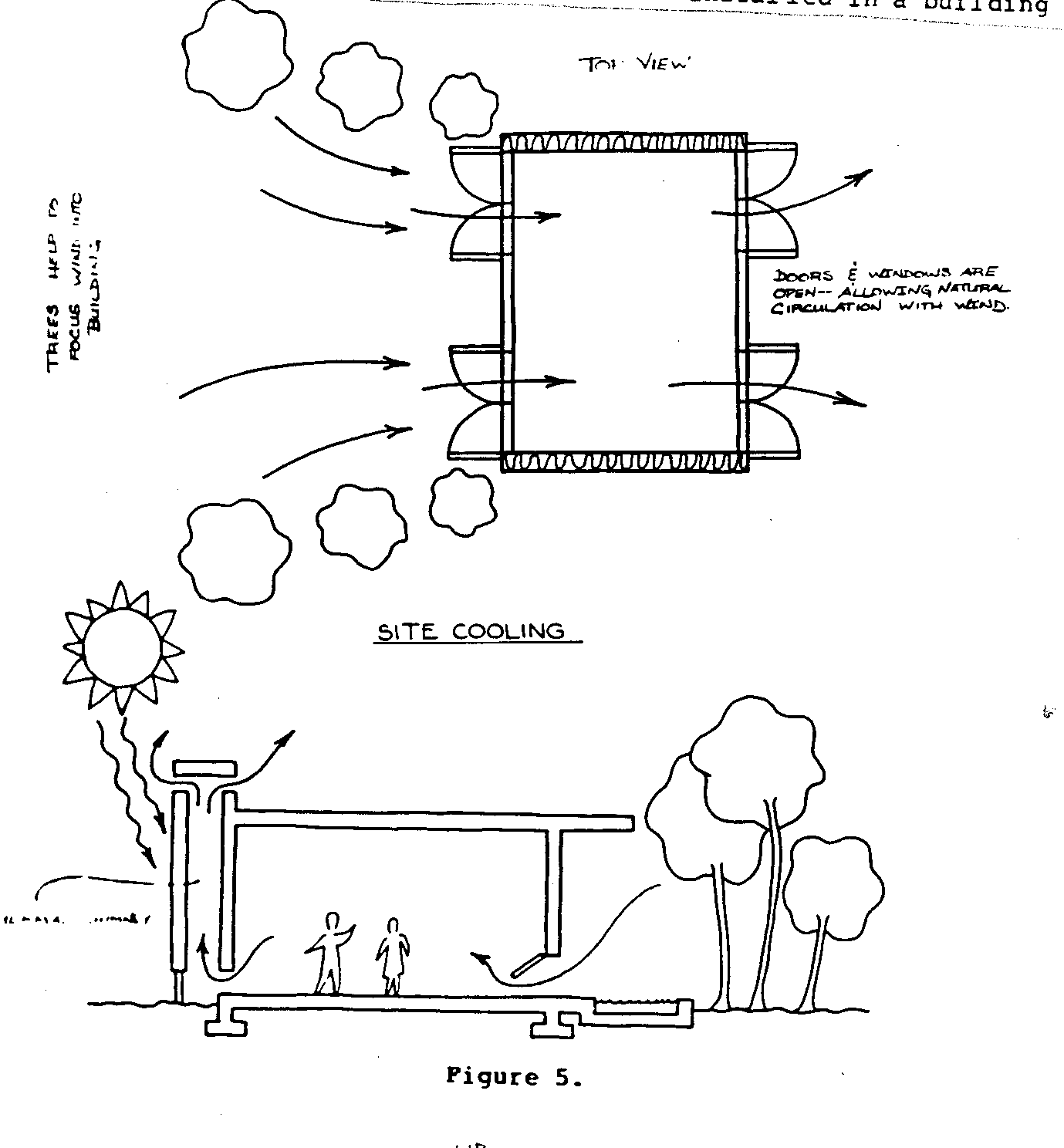
Insulation usually is considered a means of keeping heat inside a building, but it can also keep heat out and thus provide cooling in summer. If insulation was still not installed in a building originally because winters are mild, it may be economical to install it for comfort in summer.
Walls and ceilings may be filled with conventional insulation materials such as cellulose, vermiculite, rock wool, or glass fiber. Various kinds of rigid foam board may be used either inside or outside of walls. Potentially toxic materials (including those that emit toxic fumes when burning) should not be used inside. A number of materials that have insulative properties may be available locally and can serve as home made insulation. Also wood fiber, shredded sea weed, etc., can be used for insulation.
Ground Cooling
Like water, earth or subsurface rock reduces extremes of heat and cold. Although the surface temperature of soil rises during hot summer days, soil at a depth of several feet is much cooler and generally remains constant year-round. Cool cave habitats date back thousands of years, and modern versions are being built, generally for office buildings or for storage. A new generation of underground homes is popular as builders seek even temperatures year round with little or no expense for heating or cooling. These earth-sheltered homes are excavated and/or bermed with earth for added insulation.
The temperature of the earth varies according to the seasons. That is, the highest temperature at each level is reached in the summer months and the lowest temperature during the winter months in a given region.
A refinement of underground passive cooling uses subsurface tunnels, or cool pipes, to provide summer comfort for buildings. However, caution should be used in this approach. While good performance has been obtained with some cool-pipe installations,
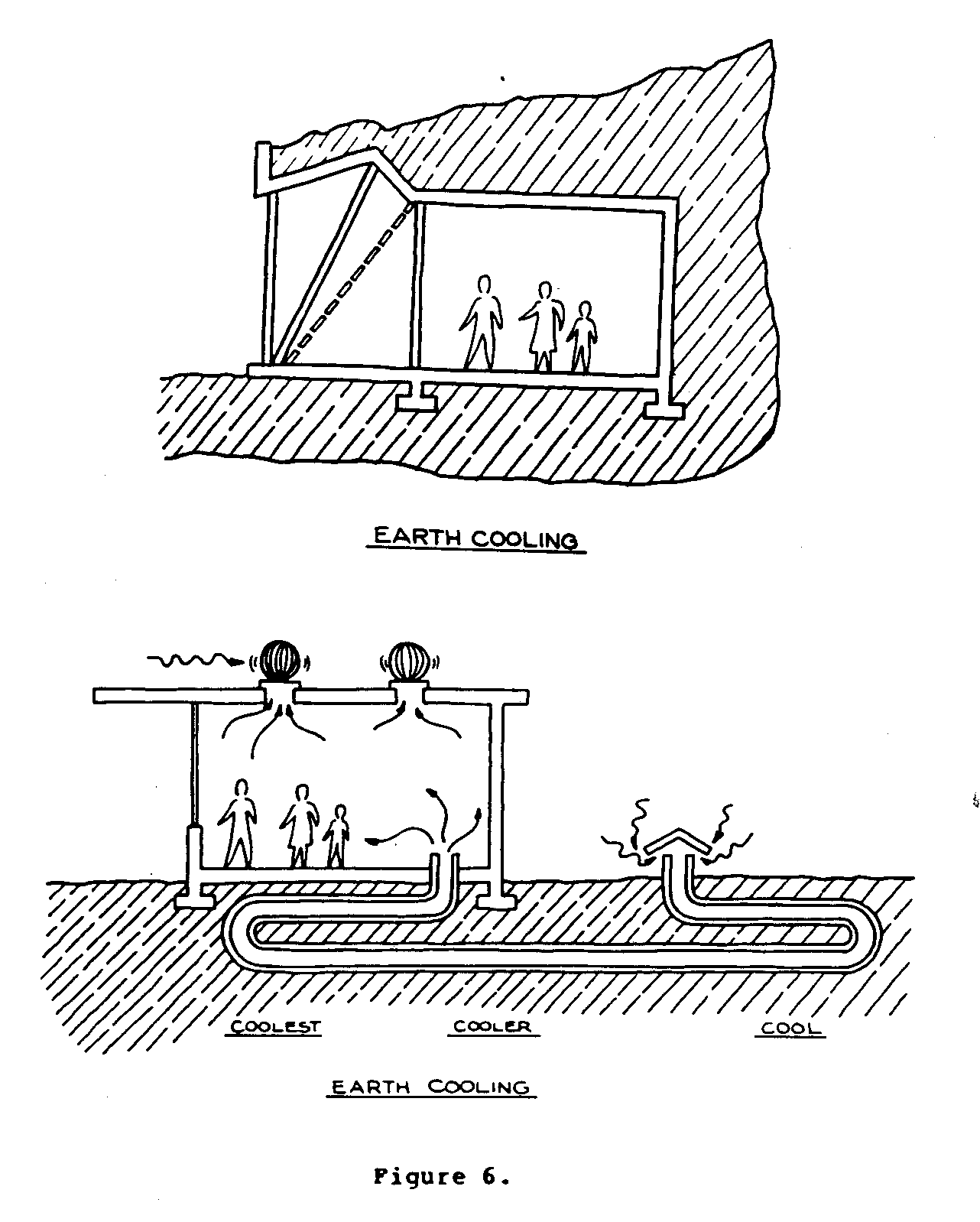
prolonged use can warm the soil to a temperature too high for comfort cooling. Unless a large volume of subsurface soil is available for very little effort and cost, only modest amounts of cooling can be expected from this technique. There are other potential problems as well, including moisture, which can encourage fungi and insect or animal life, causing adverse health conditions.
Table 1. Example of Earth Temperatures (Approximate) at Five Levels
Yearly Temperature Depth in meters Range (degrees Celsius)
Ground Surface 1 - 24
1.5 6 - 17
3 8 - 16
9 11 - 13
Source: American Institute of Architects
Wind Cooling (natural breezes or induced covection)
The cooling breezes we intuitively take advantage of should also be used to maximum benefit in passively cooling a building. See Figure 7. If outside air is appreciably cooler than inside it can
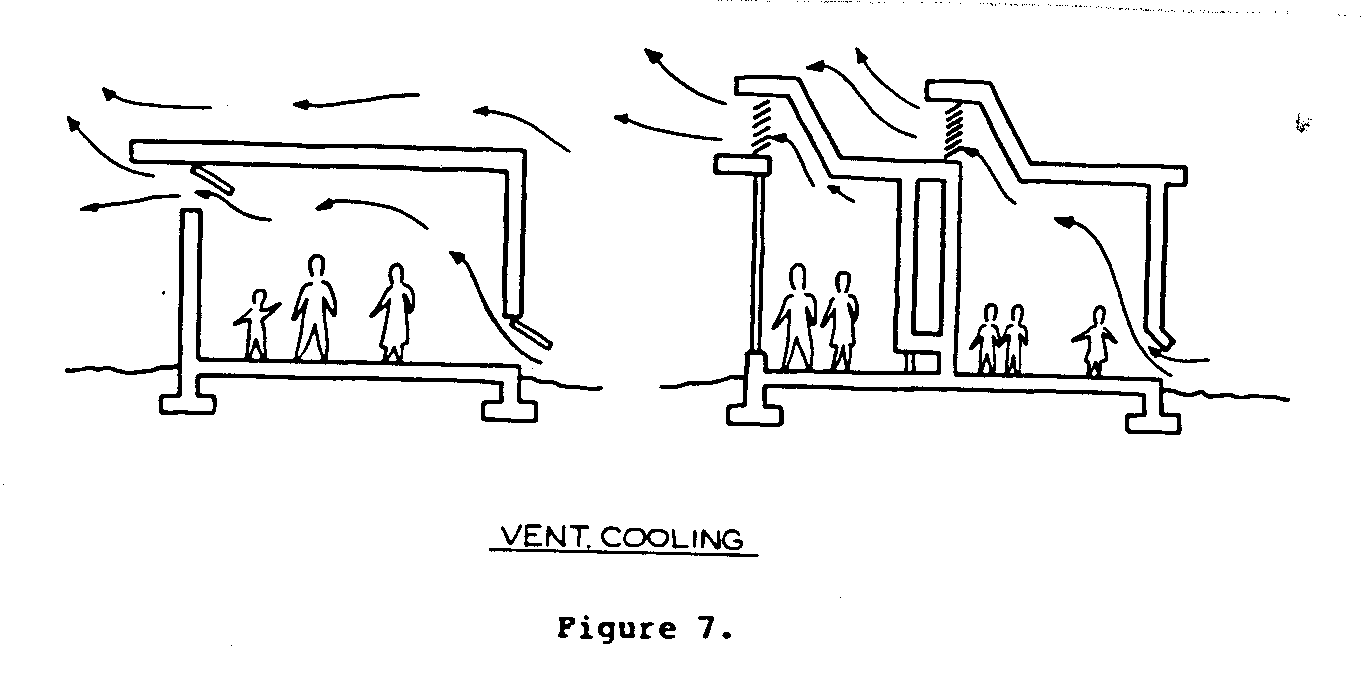
enter open windows and match the cooling power of a small air-conditioning unit. Yet it costs nothing to use. When the sun is not shining on windows, they should be opened when outside air is cooler and a breeze is blowing. They should be opened at night whenever outside air is cooler than the interior of the house.
Even if there is little or no wind, steps may be taken to induce a convective flow of air through a building to aid in cooling it. warm air naturally rises; if outlets in the form of high windows or vents are provided, this air will flow out and be replaced by cooler air coming in low openings on the shady side of the building. See Figure 8.
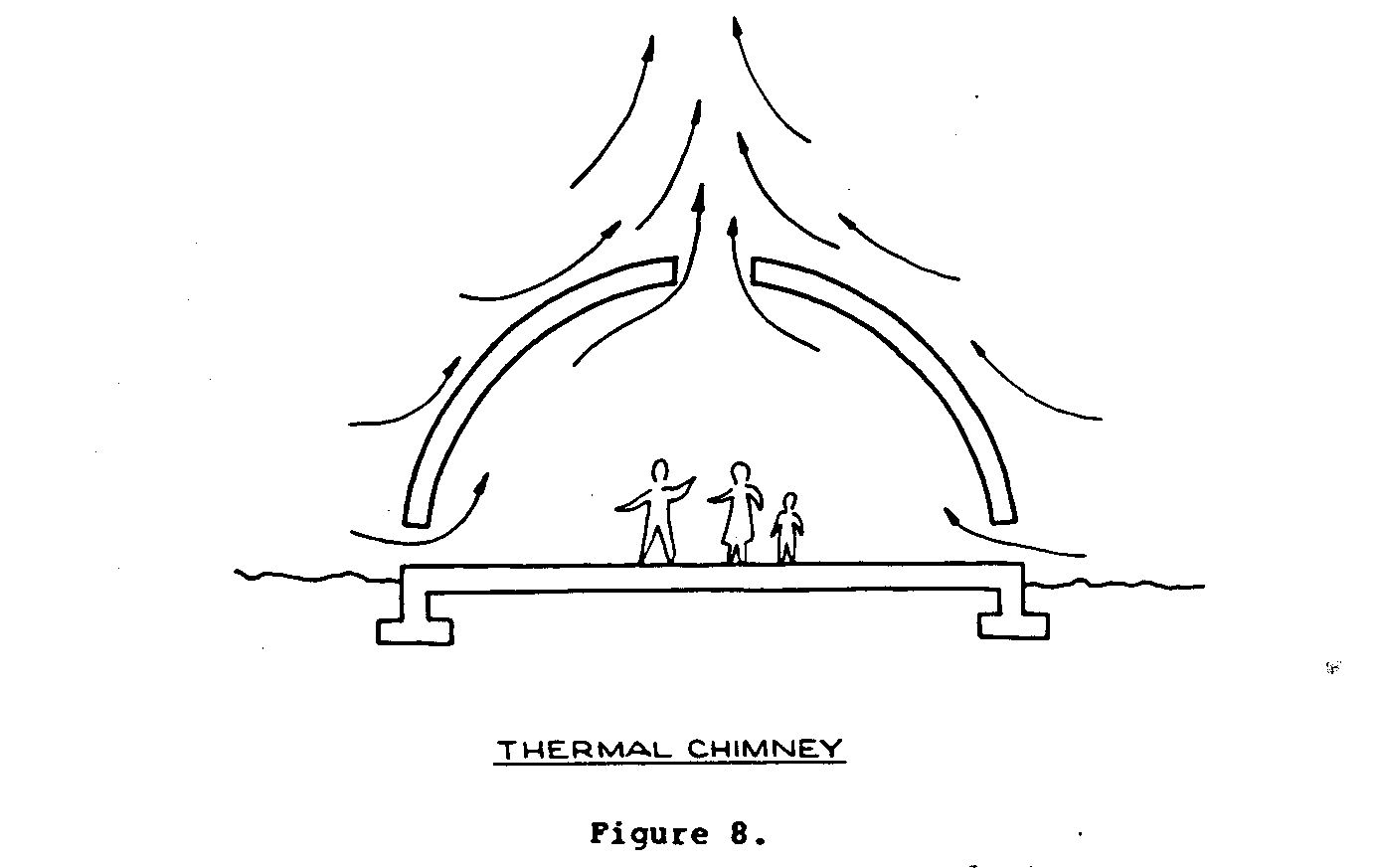
Thermal chimneys, an effective form of convective air flow, are still in use in Iran, and many newer ones have been installed elsewhere to promote the cooling flow of air through a building. The upper portion of the chimney is heated by the sun, the warm air inside rises and goes out the top and cooler air comes into the building from shaded window openings.
Water Cooling
A stream or pond may provide some passive cooling. Water can be piped or pumped through radiators to carry away surplus heat and thus cool the air inside a building. The warmed water can then be returned to its source and not be wasted.
Very cold, underground streams have been used for passive cooling of buildings.
Evaporative Cooling
Moist air sometimes provides cooling in warm climates. This technique has been used for centuries by placing pools and fountains in courtyards or other areas adjacent to buildings. Combined with a breeze from the proper direction, this natural evaporative cooling provides comfort at little cost (Figure 9).
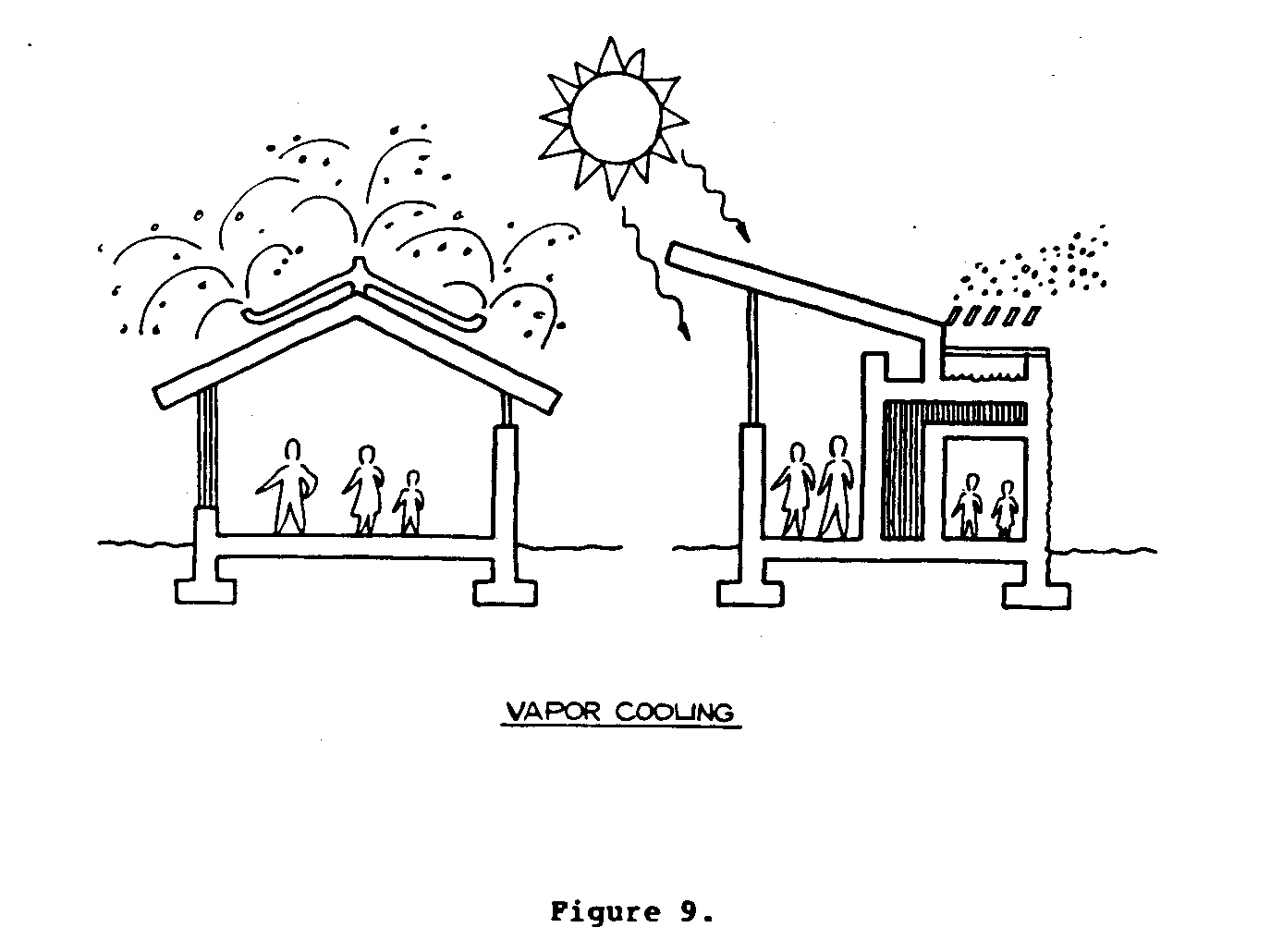
Mechanical evaporative coolers using electrically driven fans provide excellent comfort in and areas. This cooling equipment was developed slowly from primitive evaporative coolers consisting only of a wet cloth or fibrous material hung in a window or doorway exposed to a breeze. The material was periodically dipped into water, or hung so its bottom edge was in a container of water and a "wicking" action kept it wet. Such simple coolers can be improvised today with some effect.
Where water is readily available and expendable, larger applications of evaporative cooling can be made. Water can be sprayed or trickled on a roof to cool it. In some cases, a pond of water can be created on a flat, watertight roof. In dry arid climates, the evaporative effect of the pool is enhanced by night radiation of heat from the water to the night sky.
Evaporative cooling depends on a very dry climate to be effective. When the air is humid and already laden with moisture, adding more water decreases comfort. Moreover, pumping systems may be costly.
Dehumidification
Where normal evaporative cooling is not possible because of high humidity, dehumidification may provide some comfort. Barrels of salt were used many years ago in some regions to dry humid air for human comfort. Today the concept has developed into electromechanic active desiccant cooling equipment. Desiccants are substances that remove moisture f rom the air. Such systems are beyond the scope of are expensive and complex, and thus of little interest for the cooling applications discussed here. However, work is also being done on passive desiccant cooling.
Silica gel, lithium chloride, and activated charcoal are typical desiccants. Trays of such material are placed in a flow of air to remove moisture from it. As with the old-time salt barrels, however, the desiccant material must be dried periodically so that it will again absorb or adsorb water. This can be done simply by leaving the saturated desiccant in the sun, or the drying process can be speeded up by using air-type solar collectors. In either case, two desiccant systems must be used in parallel, with one in use while the other is regenerated (Figure 10).
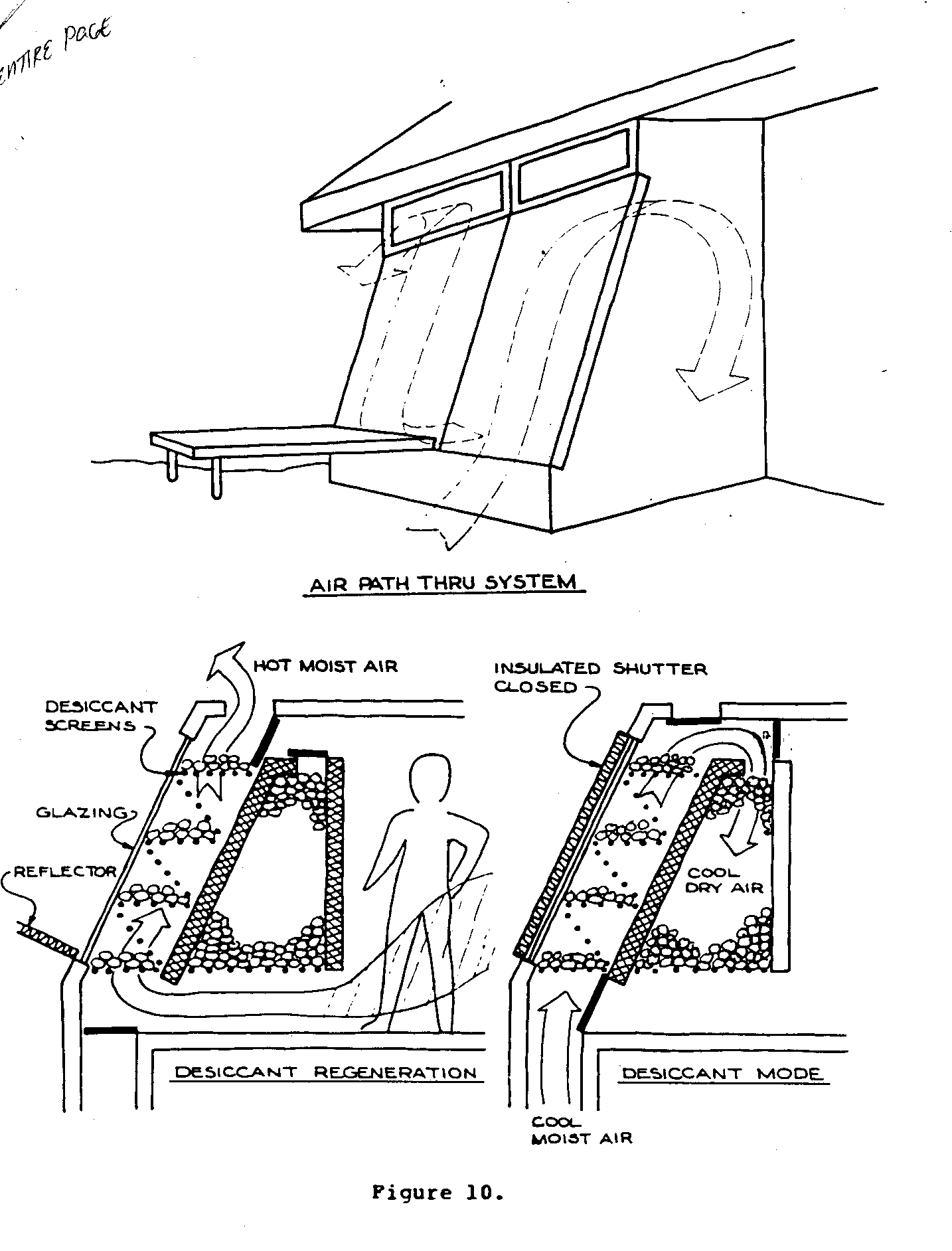
Most desiccant cooling systems use electric or gas heat for drying the desiccant material. vHowever, there are active solar-assisted desiccant systems, and even some rudimentary passive cooling systems.
Night Radiant Cooling
Even in hot desert regions, the night sky is often quite cool. This permits the radiation of large amounts of heat from a building. The Skytherm House, developed by Harold Hay, uses this principle to stay cool in summer. The flat-roofed structure is covered with warm plastic bags covered with insulation during the day but exposed to the sky at night. Simpler systems flood the flat roof to achieve similar but not as effective heat loss at night (Figure 11).
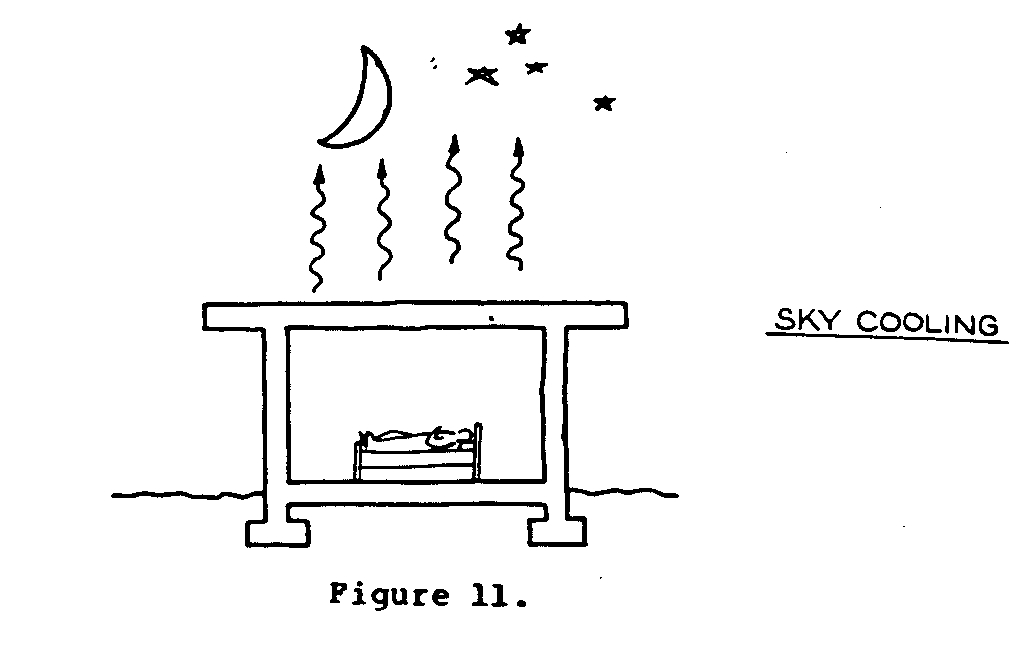
Night Cooling of Thermal Mass in Buildings
In high temperature climates, low-mass buildings minimize summer discomfort. However, many areas are hot in summer but cold in winter. Winter comfort demands a well-insulated building and this is often provided by thick earthen or masonry walls. With proper handling, such a building can also promote passive cooling.
The thick walls absorb the sun's heat during the day, keeping it from reaching the interior of the building. At night, particularly with clear skies, the building can be opened up to the cooler night air and breezes, cooling the walls and roof (Figure 12).

Cooling is enhanced by wind and radiation to the night sky, and evaporative cooling can be used also if water is available.
Exotic Passive Cooling Methods
Some work has been done in artificially producing ice, which is stored and used later for comfort cooling. This method has been used on a small scale for air-conditioning office buildings, but requires special ice-making equipment, and very well-insulated storage for the long period between winter ice-making and summer cooling.
Some experimental work has been done with special solar collectors and radiators (using zeolite heat-exchange materials) that operate day and night provide cooling or even ice. Zeolites are alumino-silicate minerals (See Figure 14). Uses have
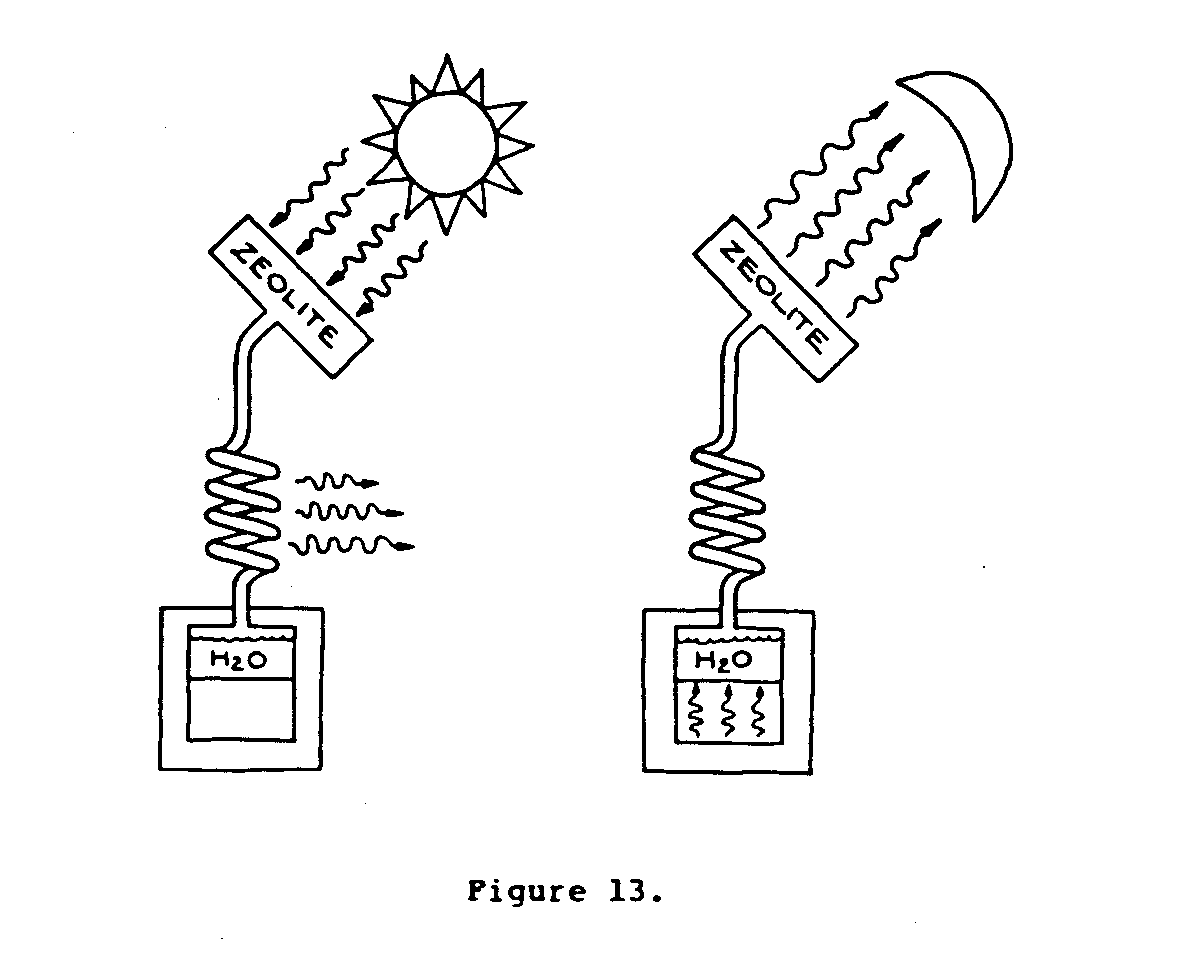
included refrigerating foods and medicines and providing cool water for showers in very hot climates. Such systems may technically be classed as passive cooling, because they require no electric power or fuel energy, but they are complex and expensive. Moreover, present passive models require design modifications to improve performance in areas where there is only a small temperature change between day and night.
III. SELECTING THE RIGHT PASSIVE COOLING SYSTEM
Choice of the appropriate passive cooling method depends on the application under consideration (residence, school, dormitory, office building, workshop; dairy or other animal structure; food, liquid, or medicine storage); on the amount of cooling required; and on the differing environmental and other conditions at the site (terrain, soil, temperature, humidity, wind, cloud cover).
The first consideration in any passive cooling project should be to keep heat generated inside the building to the practical minimum, thus reducing the need for comfort cooling. This means cooking, washing clothes and dishes, ironing, and doing other heat-producing activities outside if possible or at night. Proper dress is obviously important for comfort at relatively high temperatures. Clothing of light, absorbent materials minimize heat retention and discomfort. Wearing sandals, or no shoes at all, may be a further help.
Generally Applicable Technologies
Just as the above-mentioned tips for minimizing the need for cooling apply generally, some passive cooling technologies will be of benefit in almost all applications and climates.
Use of shade to prevent unwanted heat from entering a building is the most generally appropriate cooling measure. It should be considered first. Reflection of solar heat is also generally applicable, whether the sky is cloudy or clear, the air dry or moist. Insulation too is an all-around technique, although the type used will vary with the building construction and climatic conditions.
If cool breezes blow, they will cool inhabitants and buildings in both dry and moist climates. Induced convection can be used to vent hot air from practically all structures. This method is most effective in buildings with high ceilings.
Arid Climate Technologies
A relatively arid climate makes possible the use of water-cooling methods (evaporative cooling, roof ponds) where water is available; rejection of heat to the clear night sky; and ground cooling. Large, flat-roofed buildings such as factories, schools, and hospitals are good candidates for roof-pond cooling measures. Clear night skies make this method even more effective in getting rid of unwanted heat.
Buildings of earthen materials, masonry, and other dense materials permit the delaying of thermal action that keeps heat from reaching the inside of a building until it can be cooled at night.
Underground and earth-sheltered buildings can be built in many areas where soil is dry the year round. Underground building is seldom justifiable solely on the basis of passive cooling, however. This technique has been most effective in such places as caves of limestone or other easily worked material. Such applications are much more site-specific and thus are limited in number.
Humid Climate Technologies
In areas of appreciable humidity, dehumidification or desiccant cooling may be required. To be truly passive in operation, this cooling method depends on sufficient wind flow to carry moist air over a moisture-absorbing desiccant and into the building to be cooled. Unless solar collectors are used to continuously regenerate the desiccant, two desiccant pans must be provided: one in use while the other is being dried.
The following table is a suggested rough match of passive

cooling technologies with different applications. It should provide a starting point for analysis and planning of a project.
IV. THE FUTURE OF PASSIVE COOLING
Rudimentary forms of passive cooling have been used successfully for centuries and much-improved technology is available today. However, continued research and development suggest that even greater improvements will be possible in the future.
As population increases in hot regions and as energy becomes scarcer and more costly, the demand for passive cooling increases. Although it is presently only a minor contributor to human comfort when compared with conventional cooling methods, the growing demand will create a large potential market. This will stimulate better design and more effective systems and equipment.
Better materials and equipment for use in passive cooling seem assured because of advances in allied fields, and the increasing focus on passive cooling technologies. Among these advances are:
- Improved heat rejecting metals and other materials
- Automatic movable insulation and shading devices
- Reversible chemical reactions for heat exchange
- Selective window glazing for heat rejection
- Improved desiccant materials
Those interested in passive cooling should guard against too high expectations, however. Passive cooling does not, and probably will not in the foreseeable future, compare in effectiveness with conventional electrical and mechanical cooling techniques. But to the hot and uncomfortable person for whom such equipment is out of reach, passive cooling can be a step up in comfort at a small price.
REFERENCES
Publishing Company, 34 Essex Street, Andover, Massachusetts 01810, USA. 197 pp. $8.95. (*)
ASHRA Handbook of Fundamentals. (American Society of Heating, Refrigeration, and Air Conditioning Engineers, Publication Sales, 1791 Tullie circle, NE, atlanta, Georgia 30329, USA. 748 pp. $53.00
Baer, Steve (Zomeworks corporation, P.O. Box 25805, Albuquerque, New Mexico 87125, USA). "Cooling with Nighttime Air," Alternative Sources of Energy. Vol. 41, January/February 1980, p.22.
Baer, S. "Raising the `Open U' Value by Passive Means," Progress in Passive Solar Energy Systems. (American Solar Energy Society, Inc., 1983) Vol. 8, pp. 839-842.
Bliss, Raymond W., Jr. "Atmospheric Radiation Near the Surface of the Ground: A Summary for Engineers," Solar Energy. (International Solar Energy Sociey) July/September 1961.
Clark, Gene, et.al. (Solar Data Center, Box 500, Trinity University, San Antonio, Texas 78284, USA. "Results of Validated Simulations of Roof Pond Cooled Residences," Progress in Passive Solar Energy Systems. op.cit. pp.823-828.
Collier, R.K. (Solar Energy Research Institute) "Desiccant and other Cooling Systems, "Solar Cooling Applications[paragraph] Workshop. (1 June, 1980, Phoenix, Arizona, USA)pp. 93-109.
Earth Sheltered Housing Design. (University of Minnesota Underground Space Center, Van Nostrand Reinhold, 1979) 318 pp. $10.95 (*)
Hay, Harold. "Atascadero Residence," Passive Solar Heating and Cooling Conference and Workshop Processings, May 18-19, 1976 Albuquerque, New Mexico. (LA-6637-C) $3.00 microfiche domestic, $4.50 michrofiche foreign pp. 101-107. (**)
McPhee, John. "Ice Pond," New Yorker. 13 July, 1981, pp. 92-95.
Miller, W.C. and J.O. Bradley Energy Systems Center, Dessert Research Institute, Boulder City, NV 89005, USA). "Radiative Cooling with Selective Surfaces in a Desert Climate," Solar Cooling Applications Workshop). (1 June, 1980, Phoenix, Arizona, USA) pp. 85-90.
Next Whole Earth Catalog, Second Edition (Random House, 1981) 608 pp. $16.00 (*)
Olgyay, Aladar and V. Olgyay. Solar Control and Shading Devices. (Princeton University Press, 1967,)
Olgyay, Victor. Design with Climate. (Princeton University Press, 1963) 190 pp. (*)
Passive Cooling Handbook. (Ed. by Harry Miller.) Prepared for the Passive Cooling Workshop in Amherst, Massachusetts, USA on 20-22 October, 1980. Available from Don Elmer, Passive Cooling Working Group.
Passive Solar Design Handbook DO E/CS-0127/1 US-59. Prepared by Total Environment Action, Inc. for the US Department of Energy. March 1980. $3.00 (microfiche) (**)
Rudofsky, Bernard. Architecture Without Architects. (Doubleday & Company, 1969) 166 pp. $5.95 (*)
Schubert, R.P. and P. Hahn (Environmental Systems Lab, College of Architecture and Urban Studies, Virginia Polytechnic Institute and State University, Blackburg, Virginia 24061, USA) "The Design and Testing of a High Performance Ventilator Cowl: An Element in Passive Ventilation," Progress in Passive solar energy Systems, op.cit. pp. 867-872.
Vierira, R.K., et.al. (Physics Department, Trinity University) "Energy Savings Potential of Dehumidified Roof Pond Residences," Progress in Passive Solar Energy Systems.